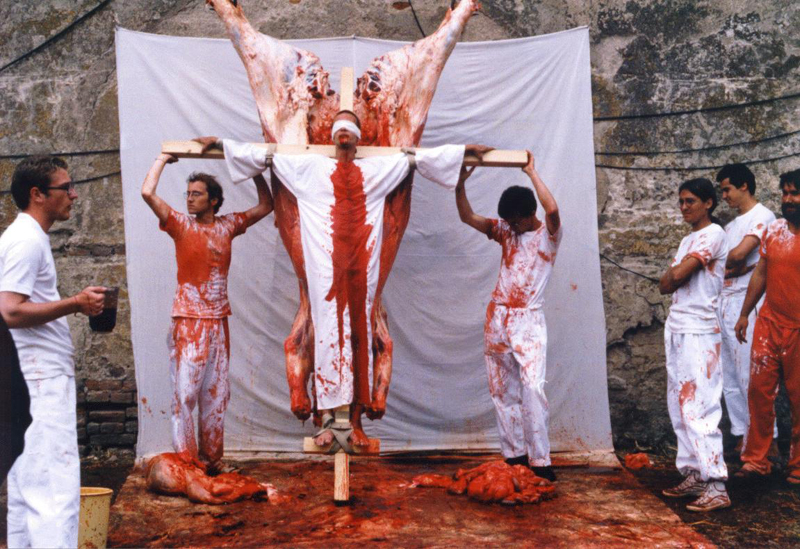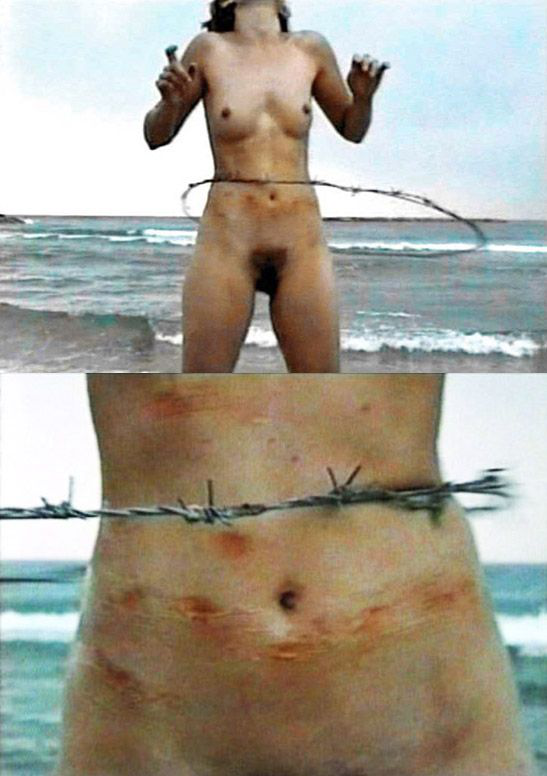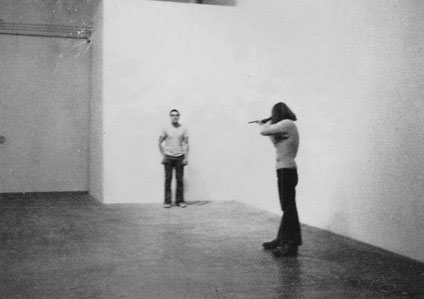Performance art has undermined the preexisting basics of art. Before it was the art piece that represented the artist, and after the performance trend has developed, it was the artist that directly presented his sensitivity to the world, it was him who exposed his body to the public that gathered in the particular chamber in the particular time. It can be filmed and screened afterwards, but in this case it somehow loses its essence. It is, therefore, an individual or a group of persons, whose actions constitute the art piece. The performance does not exist outside this specific place, as well as it does not last after the artist is gone. Or, it may be recorded and than projected, becuase the relationship between the artist and the audience will still be present, even without the artist himself.

The performance pioneers were led by an assumption of putting the greatest importance on the consciousness of the self and the world as opposed to the learnt, preestablished rules of art. Since then the artist was not forced to eliminate himself from his works, he became a living art medium, a medium that existed in a specified time and space, that was ephemeral, thus not meant to last infinitely, emphasisng human’s mortality. It is temporary.
Performance art is some kind of a record of humans’ emotions through the 20th century, and actually one may say it’s a role of art in general, but as you will see in a moment or you have participated in one in any gallery, nothing makes such straightforward impression as a human being himself directly to the viewer. As an analogy you can try to imagine a situation of a crying person a meter from you, and than a movie with a crying actor and finally a literary description of a crying person, and judge in which case would it affect you the most.

(Klaus Biesenbach, MoMA) It’s about pushing the boundaries of pain, of endurance, boundaries of danger as for example in the work of an artist walking in front of an icebreaker.
Edges of human existence and human tolerance
Marina Abramovic: Performance is not theatre, a theatre show you can repeart mostly in the same manner, while performance happens only once. In Theatre you can cut your skin with a knife, but the knife is not real and blood is not real as well. In performance everything is real.
The question that often comes with the performance is how gruesome it may be, or how uncomfortable it makes the viewer (RoseLee Goldberg, a curator at MoMA). But the scope of different performances is that vast, that it is not said all of them have to be shocking or disguisting, their role is mainly to open our eyes, souls and chiefly our consciousness.
Herman Nitsch is an artist from the group of Vienna Actionists. His art transcendents the art and life, and they become one. The observer is no longer the observer, he becomes a participant in the ritual. Nitsch claims that it is not the language that can reach our deepest corners of consciousness but an extatic sensual experience achieved through the bloody orgies which exposed the parts of human’s mind repressed by the freudian super ego. He expanses his actions from language to scream, from painting to spilling the paint, from music to noise to give vent to our brute, beastly side. It was inspired by the „Theatre of Cruelty of Antonin Artaud, the myths of Dionisos, Oedipus, Christ, who is sacrificed himself for love, Christian rituals of lamb’s sacrifice, to the suffering humanity to regenerate through allowing the repressed to come to reality. Nitsch wanted this ritual to be repeated every year in the same time, to cure the human beings even after his death, but his efforts were pushed to their end when Nitsch was arrested due to his „Aktionen”.

As Nitsch himself said: „basic experience of excess and a celebration of resurrection, a sadomasochist excess and catharsis, a brutal dismemberment and a harmonising synthesis, an incantation of the myth as a contracted world view and psychoanalytical therapy”
Sigalit Landau’s performance from the first sight has strong sexual, feministic connotations due to the nudity of the artist. Moreover, spinning of the hula hoop, especially naked, reminds a sexual act, which sensuality is broken due to the thorns on the hoop, as the artist was emphasising the expectations, social and cultural influence put upon women. The barbed circle is an enlarged version of the Christ’s crown of thorns, thus it suggests her being a universal suffering woman, and additionally she stands on the Isreali seashore, so that the crown can be given a primary meaning of the Israel martyr population. She refers to this part of the coutry as „the only calm and natural border Israel has” as she was cumulating the country’s pain wholly in her waist freeing it from the danger from the neighbouring Palestinians.

Guido van der Werve in an interview said „Dwelling in melancholy is one of my favourite activities”. The melancholy is here symbolised by the giant icebrekeaker that follows the artist somehow indefinitely with the same pace as his. It is a great danger. What if Werve stopped for a minute, what if the machine increased its speed? The icebreaker is a demon that follows us throughout the whole life, since childhood to the death when the evil finally shuts our breath.
In 1976, a critic, Robert Horvitz, in his Artforum article asked the question: 'To what extent are we justified in suspending our moral judgment when the material being worked is human?’ The question perfectly fits in Burden’s controversial performance when he is shot by a friend of his. Being afraid of the police’s intervention he organised the show not at the Duchamps festival at his university, but at his own gallery space, where he invited just a small group of people, that he warned before the performance. Another critic, Christine Stiles claims, he 'responsibly performed the piece under ethical conditions’. But to what extend was it actually correct to push the public to watch his artwork on the border between life and death what may even expanded with the collective responsibility, if Burded was severely shot.

Marina Abramovic and her partner, Ulay are holding bow and arrow pointing at Marina’s heart. Any uncontrolled movement can bring fatal effects and the microphones stuck to artists’ clothes record Ulay’s irregular breathing. The viewer, as in the Burden’s performance is coresponsible for the possibility of Marina’s death. The performance is based on their love’s trial of trust, that is judged not only by the lovers, but also by the audience.
In this last, and to be the most disguisting performance, Stelarc has his skin pierced with the giant hooks and then elevated to the half of the height between the sculpture of the arm with an ear, the symbol of breaking the limits of human’s body, and the ceiling. Stelarc, in his artworks, mainly in the 25 suspensions he performed, shows the man’s primal desire to overcome the force of gravity, and more metaphorically to reach God’s position. For the artist, human’s body should still be the subject of evolution, and moreover it’s ridiculous for him that in the age of information, of technology, human still is not able to push his natural boundaries as he did with dozens of other thingsm, or reached the Moon. So, Stelarc shows the man floating between two extremes, earthly and supremacy, and in the same time he shows the audience the limits he overcomes. In front of their eyes he experiments with himself and while he is suffering physically, the observes have to deal with it psychically.

On one hand all of the performances shown, force us to watch brutality, danger or some unbelievable strain of the artist, what may be considered as unethical or just stupid. Some of you may claim, that it is ridiculous to do performances with the possibility of death, or violating the taboos. And furthermore, it can be seen as useless, unvaluable act of an attention seeking person, who then, due to the high controversy because of challenging the preexisting morality.
But, on the other hand these performances expand our, and the artists’ experience, the experience we have never had before. Yes, they do challange the morality, but maybe it is necessary to do it, as it is created by human, it can be ass well altered by him. The artists also focus on breaking the taboos, as for example Sigalit Landau in the „Barbed Hula” or Nitsch in the „Orgien Mysterien Theater”.
The shared features of them all are manifestos against, not only the political, economical, or cultural issues, but only against the limits of human being itself. I think it is crucial to maintain performance in its existence, because it gives the valuable, experiencial knowledge to our consciousness and as it is the most straightforward method of sharing the views, manifesting or communicating, directly through the emotions, it’s probably also the simplest to understand for the viewer, even in the most basic way without the sophisticated interpretation.
OA